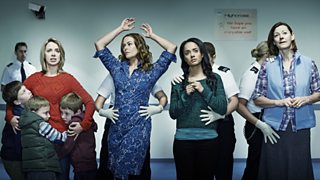A prostitute in a library or a pregnant woman with an AK47: What exactly are 'good' female characters?
Sally Stott
Writersroom Reader
“Something must be done,” people on stage are saying to people in the audience who are saying it back to them. I’m at a post-show discussion. It follows twelve short plays aiming to depict women in new and interesting ways. The evening’s been organised by as a response to showing that there are twice as many roles for men as women in theatre. Things aren’t any better in film and TV with by the �鶹Լ�� and Cultural Diversity Network highlighting that men also outnumber women 2:1 on screen.
��
Despite this, lots of people want more and better characters for women. In February, I wrote a ��trying to encourage some into the Script Room. But what exactly does a ‘good’ female character mean? Is she someone who breaks down the barriers of a patriarchal society using only a rolled up copy of the Guardian? Is she the familiar wife, daughter or girlfriend but with better dialogue? Or perhaps she’s so different to everything we’ve seen before that we’d struggle to recognise her?

Prisoners' Wives
The majority of the plays at the Equal Writes evening, selected from hundreds of entries, do three things.
��
•�������������������������������������� They show women in a believable way.
•�������������������������������������� They undermine how women are sometimes seen by others.
•�������������������������������������� They’re funny.
��
Some are naturalistic, some are stylised or satirical. Walkie Talkies, by Kaite O’Reilly, is a disabled woman’s critique of life in a super caring care home. Andrew Curtis’s Flags shows two older women from different backgrounds arm wrestling over their heritage. Sarah Rutherford’s La Barbe is a surrealist comedy about office culture. Paul Macauley’s Piece of Cake is a family drama that ridicules the advertising industry.
��
The twelve scripts contain lots of original ideas but also some familiar ones: for instance, older women needing to be looked after, women fighting over men, and mother and daughter relationships. The difficultly in creating a completely original female character is that she also has to be identifiable - someone we can recognise. And what we recognise is partly informed by film and TV - places where female characters can be shown in limited ways.
��
So what can writers do to avoid regurgitating the same types of women, while still giving audiences something they can identify with and understand?
��
A way Hollywood tries to get around this is to turn female characters into men. Action films are full of literally ‘strong’ women, just as capable as blokes, with durable clothing and an AK47 to prove it. Famously Ripley from the Alien films was written as a man. Recently, The Killing’s Sophie Gråbøl said she played Detective Inspector Sarah Lund as if she was male (). Both are generally seen as examples of good female characters. However, getting rid of a female characters’ sexuality in order to make her less female and, presumably, less rubbish seems a rather convoluted and, in some ways, destructive way of making her ‘good’.
��
Another popular technique is to place female characters in traditionally male-orientated genres, as with Thelma and Louise. In some ways the audience knows what to expect (a road trip) and in some ways they don’t (female protagonists). More recently, Bridesmaids fuses elements of the ‘gross-out’ film – a genre normally populated by teenage boys or men pretending to be them - with a female-driven romantic comedy. In both instances, the characters aren’t so outlandish it’s impossible to relate to them, but they aren’t completely familiar either.
��
Cartoonist Alison Bechdel created The , which can be used to test how well women are portrayed in any kind of comedy or drama. For your script to pass, all you need to do is answer the following questions with “yes”:
��
•�������������������������������������� Are there two or more women who have names?
•�������������������������������������� Do they talk to each other?
•�������������������������������������� Do they talk to each other about something other than men?
��
How did you get on?

Miranda
Good characters, both male and female, also have flaws. One of the dullest kinds of female supporting roles is the voice-of-reason, trying to rein in the behaviour of maverick larger-than-life men (��of The Incredible Burt Wonderstone). Sometimes a better female character means one who’s worse. Miranda isn’t popular because she’s perfect. Neither are Patsy and Edina, from Absolutely Fabulous - one of the few series where female characters significantly outnumber male ones. Equity’s Joan Blackham, who has been compiling informal statistics on the number of women in TV shows, also highlights Call the Midwife and Prisoners’ Wives as examples of good dramas where there is a fairly equal ratio of male to female characters.

�鶹Լ�� One Drama - Call the Midwife
Back at Equal Writes, lots of impassioned people are talking about something called ‘gender parity’. Paul Macauley, the writer of Piece of Cake, later admits on his that he hasn’t a clue what this means. I doubt he’s alone. It’s true, something does need to be done, but you can only achieve so much in a post-show discussion. The real power lies with those who write and produce enjoyable scripts.
��
Sally blogs about film, TV and other stuff at
She is also on Twitter @sallystott
